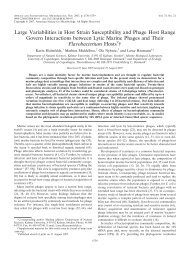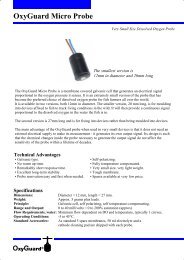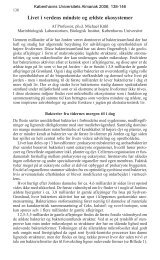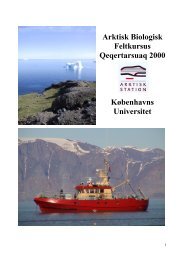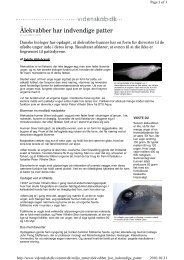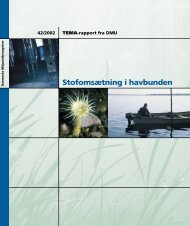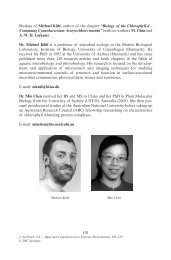Measurement of chlorophyll fluorescence within leaves ... - Springer
Measurement of chlorophyll fluorescence within leaves ... - Springer
Measurement of chlorophyll fluorescence within leaves ... - Springer
Create successful ePaper yourself
Turn your PDF publications into a flip-book with our unique Google optimized e-Paper software.
107<br />
Fm . . . . . . . . . . . . . . . . . . . . . . . . . . . . . . . . . . . . . . . . . . . . . . . . . .<br />
Fv<br />
t tl ,<br />
ML on<br />
SP<br />
Fv<br />
500 ms<br />
Fig. 4. Determination <strong>of</strong> maximal quantum yield Fv/Fm by the<br />
saturation pulse method at a depth <strong>of</strong> 80/~m <strong>within</strong> a leaf <strong>of</strong> Syringa<br />
vulgaris. Single recording at measuring light intensity setting 10<br />
and damping setting 7 at PAM-101. The measuring light intensity<br />
at the fiber tip amounted to 20 IzE m -2 s -l at 1.6 kHz modulation<br />
frequency and 1240 p,E m- 2 s- 1 at 100 kHz (during 0.6 s saturation<br />
pulse).<br />
caused photoinhibition, associated with a loss in maximum<br />
quantum yield (Powles and Bjtrkman 1982). As<br />
shown in Fig. 5 (photoinhibited curve), a substantial<br />
drop in Fv/Fm to a value <strong>of</strong> 0.51 was observed at 20 #m<br />
distance from the adaxial surface, whereas only minor<br />
effects were found when the fiber tip was at 60-20<br />
#m distance from the abaxial surface (i.e. at 140-180<br />
/zM depth, measured from the adaxial surface). The<br />
data show a gradual decrease <strong>of</strong> photoinhibition <strong>within</strong><br />
the leaf with increasing distance to the leaf surface<br />
at which the photoinhibitory illumination was applied,<br />
While these results are not unexpected in view <strong>of</strong> the<br />
fact that the intensity <strong>of</strong> the externally applied light<br />
drops rapidly <strong>within</strong> the leaf (Vogelmann and Bjtrn<br />
1984; Bornman et al. 1991), they demonstrate that the<br />
overall photoinhibition is likely to be overestimated,<br />
when, as has been common practice, it is assessed by<br />
<strong>fluorescence</strong> measurements from the leaf surface.<br />
Conclusions<br />
E<br />
It.<br />
0.9<br />
0.8<br />
E 0.7<br />
-~ 0.6<br />
o<br />
E<br />
._. 0.5<br />
x<br />
0.4<br />
control<br />
photoinhibited<br />
I I I I I I I I I<br />
20 40 60 80 100 120 140 160 180<br />
Depth, pm<br />
Fig. 5. Maximum quantum yield Fv/Fm measured <strong>within</strong> a leaf<br />
<strong>of</strong> Syringa vulgaris in dependence <strong>of</strong> the distance <strong>of</strong> the fiber tip<br />
from the adaxial leaf surface. A segment <strong>of</strong> the leaf was pretreated<br />
by 5 min exposure to 5000 p,E m-2 s-] white light from the<br />
adaxial surface. During the photoinliibitory treatment the leaf segment<br />
was submersed in cold water. Between the treatment and start<br />
<strong>of</strong> the measurements, 45 rain dark-time was given for recovery <strong>of</strong><br />
non-photochemical quenching which is not due to photoinhibition.<br />
Data were collected by advancing the fiberoptic microprobe either<br />
from the adaxial surface (20-100 #m) or from the abaxial surface<br />
(120-180 #m). Other measuring conditions as described for Fig. 4.<br />
Fv/Fm was almost constant, showing high values <strong>of</strong><br />
0.77-0.80 (see control curve in Fig. 5). A different<br />
result was obtained when a leaf had been pretreated<br />
by excessive illumination from the adaxial side, which<br />
It may be concluded that detailed information on the<br />
photosynthetic performance <strong>of</strong> different tissue layers<br />
<strong>within</strong> a leaf can be obtained by a PAM Fluorometer<br />
combined with a fiber-optic microprobe and an ultrasensitive<br />
emitter-detector unit. With a 20 #am fiber tip<br />
the spatial resolution is similar to cell size. As the signal/noise<br />
ratio was very satisfactory, in principle still<br />
smaller tip diameters are possible. So far, however,<br />
in experiments with a 12/ira tip we encountered relatively<br />
frequently the phenomenon <strong>of</strong> an irreversible<br />
<strong>fluorescence</strong> increase, associated with the loss <strong>of</strong> quantum<br />
yield (data not shown). This presumably was due<br />
to local cell damage, loss <strong>of</strong> compartmentation and<br />
adhesion <strong>of</strong> free chloroplasts to the fiber tip. This was<br />
not a serious problem in the case <strong>of</strong> 20/zm tip used in<br />
the present study (see e.g. Fig. 2).<br />
The new measuring system opens the way to a pr<strong>of</strong>ound<br />
assessment <strong>of</strong> the specific contributions <strong>of</strong> various<br />
leaf regions to the overall photosynthetic activity.<br />
This may be considered an important step forward<br />
towards an integrative modelling <strong>of</strong> leaf photosynthesis,<br />
the theoretical basis for which has been<br />
advanced by Fukshansky and co-workers (Fukshansky<br />
and Martinez v. Remisowsky 1992; Fukshansky et al.<br />
1992; Martinez v. Remisowsky et al. 1992). Fiberoptic<br />
microprobe measurements can provide information on<br />
the vertical gradient <strong>of</strong> photosynthetic activity <strong>within</strong><br />
a leaf, while <strong>fluorescence</strong> image analysis provides<br />
information on the lateral distribution, as viewed from




